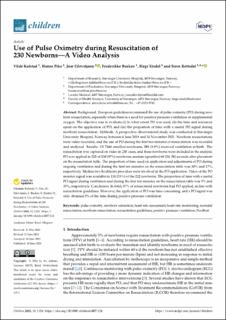| dc.contributor.author | Kolstad, Vilde | |
| dc.contributor.author | Lillevik, Hanne Markhus | |
| dc.contributor.author | Eilevstjønn, Joar | |
| dc.contributor.author | Buskov, Frederikke | |
| dc.contributor.author | Ersdal, Hege Langli | |
| dc.contributor.author | Rettedal, Siren | |
| dc.date.accessioned | 2024-03-26T11:45:17Z | |
| dc.date.available | 2024-03-26T11:45:17Z | |
| dc.date.created | 2023-09-26T11:01:03Z | |
| dc.date.issued | 2023 | |
| dc.identifier.citation | Kolstad, V., Pike, H., Eilevstjønn, J., Buskov, F., Ersdal, H., & Rettedal, S. (2023). Use of Pulse Oximetry during Resuscitation of 230 Newborns—A Video Analysis. Children, 10(7), 1124. | en_US |
| dc.identifier.issn | 2227-9067 | |
| dc.identifier.uri | https://hdl.handle.net/11250/3124209 | |
| dc.description.abstract | Background: European guidelines recommend the use of pulse oximetry (PO) during newborn resuscitation, especially when there is a need for positive pressure ventilation or supplemental oxygen. The objective was to evaluate (i) to what extent PO was used, (ii) the time and resources spent on the application of PO, and (iii) the proportion of time with a useful PO signal during newborn resuscitation. Methods: A prospective observational study was conducted at Stavanger University Hospital, Norway, between 6 June 2019 and 16 November 2021. Newborn resuscitations were video recorded, and the use of PO during the first ten minutes of resuscitation was recorded and analysed. Results: Of 7466 enrolled newborns, 289 (3.9%) received ventilation at birth. The resuscitation was captured on video in 230 cases, and these newborns were included in the analysis. PO was applied in 222 of 230 (97%) newborns, median (quartiles) 60 (24, 58) seconds after placement on the resuscitation table. The proportion of time used on application and adjustments of PO during ongoing ventilation and during the first ten minutes on the resuscitation table was 30% and 17%, respectively. Median two healthcare providers were involved in the PO application. Video of the PO monitor signal was available in 118 (53%) of the 222 newborns. The proportion of time with a useful PO signal during ventilation and during the first ten minutes on the resuscitation table was 5% and 35%, respectively. Conclusion: In total, 97% of resuscitated newborns had PO applied, in line with resuscitation guidelines. However, the application of PO was time-consuming, and a PO signal was only obtained 5% of the time during positive pressure ventilation. | en_US |
| dc.language.iso | eng | en_US |
| dc.publisher | MDPI | en_US |
| dc.rights | Navngivelse 4.0 Internasjonal | * |
| dc.rights.uri | http://creativecommons.org/licenses/by/4.0/deed.no | * |
| dc.title | Use of Pulse Oximetry during Resuscitation of 230 Newborns—A Video Analysis | en_US |
| dc.type | Peer reviewed | en_US |
| dc.type | Journal article | en_US |
| dc.description.version | publishedVersion | en_US |
| dc.rights.holder | The authors | en_US |
| dc.subject.nsi | VDP::Medisinske Fag: 700 | en_US |
| dc.source.volume | 10 | en_US |
| dc.source.journal | Children | en_US |
| dc.source.issue | 7 | en_US |
| dc.identifier.doi | 10.3390/children10071124 | |
| dc.identifier.cristin | 2178918 | |
| cristin.ispublished | true | |
| cristin.fulltext | original | |
| cristin.qualitycode | 1 | |

